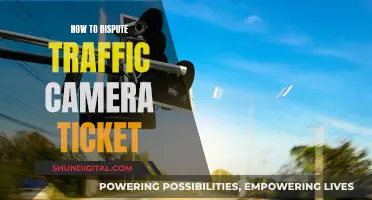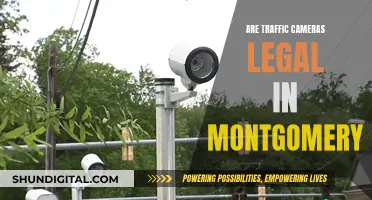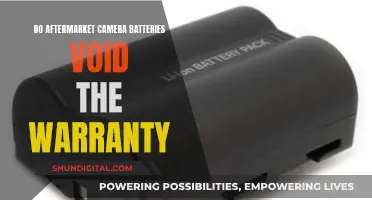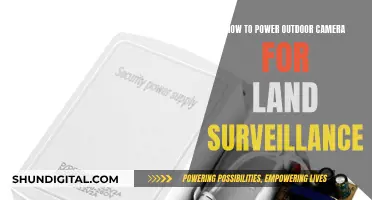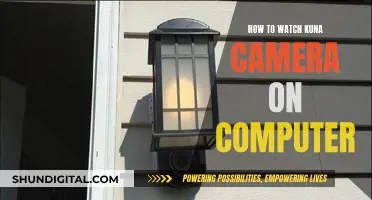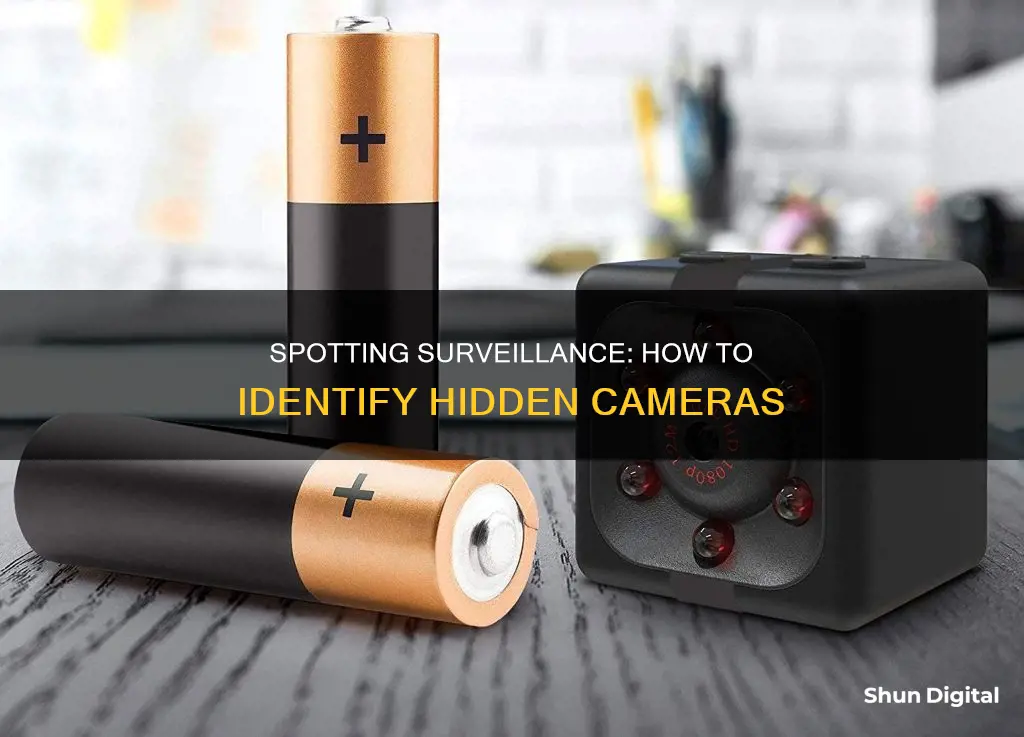
Surveillance cameras are a real danger and can be hidden anywhere, from hotel rooms to public restrooms. They can be as small as a pinhole or a couple of inches in diameter and are often disguised as everyday objects like smoke detectors, clocks, USB hubs, and even wireless chargers.
- Scan the environment carefully for spy cams. Check private areas, look out for unfamiliar objects, and use a flashlight to look inside smoke detectors and lighting fixtures.
- Check for keyholes, holes, or unusual objects that could conceal a camera lens.
- Use a radio frequency (RF) detector to locate hidden cameras by detecting their radio frequency emissions.
- Use a mobile phone camera or infrared detector to find infrared (IR) cameras. Point your phone's camera around the room and look for bright red dots on the screen.
- Use a flashlight to look for unusual reflections from objects.
- Use your cell phone to scan for interference by making a call and walking around the room. Listen for crackling, clicking, or buzzing.
| Characteristics | Values |
|---|---|
| Size | Small enough to be hidden in everyday objects such as smoke detectors, clocks, and chargers. |
| Appearance | Lenses are usually visible. May have red or green indicator lights. |
| Power Source | Often connected to a power outlet or battery. Wireless cameras may be powered by Wi-Fi or battery. |
| Placement | Common locations include private areas, such as bedrooms and bathrooms, as well as public spaces like stores and workplaces. |
| Detection Methods | Use a smartphone camera or flashlight to look for reflections or infrared lights. Scan the Wi-Fi network for unknown devices. Use a dedicated RF detector or a camera detector app. |
What You'll Learn

Look for odd objects
Surveillance cameras can be disguised as almost anything, from vents and power outlets to unassuming objects like humidifiers and TV remotes. They can be hidden absolutely anywhere, so it's important to look at every corner of a room. Any location that provides a good viewing angle could be a potential hiding place.
One way to spot surveillance cameras is to look for odd objects. For example, is there a smoke detector in a strange place, or one that looks different from the others? Are there any objects with suspicious wires, lights, or lenses? Are there any unusual power outlets or adapters? Unplug them immediately.
Another thing to look out for is an object that seems oddly positioned. For example, a USB hub in a place with no other electronics, or a room with more than one smoke detector.
If you touch a standard mirror and look at your finger from an angle, your reflected finger won't touch your actual finger. However, if you do the same thing with one-way glass, your finger and its reflection will appear to touch. So, if you see what looks like a mirror, try this test to check that it's real.
Camera Tickets: Legal in Tennessee?
You may want to see also

Check for keyholes, holes or unusual objects
When looking for surveillance cameras, it's important to check for keyholes, small holes, or unusual objects that could conceal a camera lens. Surveillance cameras can be as small as a pinhole or a screw, so it's crucial to inspect any small details that could be hiding a camera.
- Inspect any keyholes or small holes in walls, doors, or objects. Use your fingers to feel for lenses over or inside these holes, as your eyes may not be able to detect them.
- Be cautious of unusual objects or objects that seem out of place. Look out for objects that have been slightly moved or misplaced, as these could be signs of hidden cameras.
- Pay attention to electrical outlets, door locks, and debris close to walls. If you notice anything suspicious, such as misfitted outlets or sticky locks, it could be a sign of a hidden camera.
- In unfamiliar spaces like hotel rooms and vacation rentals, carefully examine clocks, smoke detectors, and air filters. If you notice multiple smoke detectors close to each other or a low-hanging clock, it may be worth inspecting them further.
- Be cautious of mirrors, especially if they are built into the wall. You can test if a mirror is a two-way mirror by knocking on it and listening for a hollow sound, or by observing if your finger touches your reflected finger.
- Use a flashlight to shine a bright light across the room, especially in suspicious areas. Look for any reflections, especially blue or purple lights, as you move the light around.
- Use your smartphone camera to detect infrared lights emitted by hidden cameras. Most surveillance cameras emit infrared light, which your phone camera may be able to detect as bright red dots on the screen.
- Download a hidden camera detector app on your smartphone. These apps use various methods, such as radio frequency detection, infrared detection, and network scanning, to locate hidden cameras.
Surveillance Cameras: Can They Hear as Well as See?
You may want to see also

Use a mobile phone camera or infrared detector
Surveillance cameras are an increasing concern for personal privacy. They can be hidden almost anywhere, from smoke detectors to USB chargers. Fortunately, there are ways to detect them using a mobile phone camera or an infrared detector. Here are some detailed instructions on how to do this:
Using a Mobile Phone Camera:
- Make a phone call: Keep a call with a friend or family member on hold and walk around slowly. If there is a hidden camera nearby, it may interfere with the phone call signal. Any signal interference in a specific place or position could indicate the presence of a hidden camera.
- Use the front camera: The back camera on most smartphones has an IR filter, while the front camera does not. In a dark room, point an infrared TV remote at your smartphone's front camera and press any button. If you see a light on the screen, your camera can detect infrared light.
- Scan the room: Turn off all the lights and use your smartphone's front camera to scan the room slowly. Look for any suspicious lights, such as white or purple dots, which could indicate the presence of an infrared-equipped camera.
- Download a hidden camera detector app: There are apps available for both Android and iPhone that can help detect hidden cameras. These apps use methods such as detecting electromagnetic fields, light reflecting off lenses, or Bluetooth and Wi-Fi connections to find hidden cameras.
Using an Infrared Detector:
Infrared detectors can be used to find infrared-equipped surveillance cameras. Here's how to do it:
- Turn off the lights: Make sure the room is as dark as possible by turning off the lights and drawing the curtains.
- Use an infrared detector: Slowly scan the room with the infrared detector. Look for any blinking or shining red or infrared lights, which could indicate the presence of a hidden camera.
While these methods can be effective in detecting hidden surveillance cameras, it's important to note that they may not always work. Hidden cameras that are not connected to a network or equipped with infrared capabilities may go undetected. Additionally, other devices in the area, such as computers or smart assistants, can interfere with the detection process.
Baltimore Camera Tickets: Your Guide to Fight Fines
You may want to see also

Use a flashlight
Using a flashlight is one of the simplest and most effective ways to detect hidden cameras. It is a useful method to employ when you first enter a new space, such as a hotel room or Airbnb, where you may suspect surveillance.
To use this method, turn off all the lights in the room and slowly scan the area with the flashlight, checking for any reflective lenses that could indicate a hidden camera. This technique works because the flashlight will reflect off the camera lens, making it easier to spot. It is best to perform this check in a dark room, as the camera lens will be more visible.
In addition to a flashlight, you can also use your smartphone to detect hidden cameras. Simply point your phone's camera around the room and look for any bright red dots that appear on the screen, indicating the presence of infrared light, which is used by most cameras.
It is important to be vigilant and thorough when checking for hidden cameras, as they can be disguised as everyday objects and may be located in private areas such as bedrooms and bathrooms.
Focusing on Security: Adjusting Your Store Cameras for Clarity
You may want to see also

Use a radio frequency detector
Radio frequency (RF) detectors are an effective way to locate and identify hidden cameras by detecting the camera's radio frequency emissions. They are an important tool in countering illegal surveillance and can be purchased online or in stores for as little as $20.
RF detectors work by capturing, analysing, and interpreting RF signals. There are several ways they can find these signals, including:
- Field Strength Detection: RF detectors can measure the strength of an RF field in the area by using a sensor to detect the signals, then turning them into an electrical signal which the detector amplifies to determine wave strength.
- Frequency Detection: RF detectors can identify the frequencies of RF signals by scanning and finding its frequency, then comparing it to others to identify the specific range.
- RF Interference Detection: RF detectors can monitor the RF spectrum for unexpected signals and alert you if they find one.
When using an RF detector to find hidden cameras, it is important to first turn off and unplug all devices that send out radio signals, including kitchen appliances, baby monitors, routers, modems, and TVs. These devices may affect the detection result.
RF detectors can be particularly useful for finding well-hidden cameras, and there are a variety of models available depending on your needs and budget. For example, if you are looking for a simple device to check a strange hotel room or Airbnb, a small, portable, and discreet RF detector might be a good option. On the other hand, if you require a professional device to scan a large area, you might choose a detector that combines RF signal detection with lens detection.
It is also worth noting that RF hidden camera detectors only pick up a certain kind of frequency. If the hidden camera uses multiple frequencies changing rapidly, the detector might not be able to detect it. However, this is unlikely as these types of cameras are much more expensive.
In addition to RF detectors, there are several other ways to detect hidden cameras, including manual inspection, using a smartphone camera and apps, infrared scanners, and Wi-Fi network scanning.
Mastering Manual Focus: Forcing Your Camera to Focus
You may want to see also
Frequently asked questions
One of the easiest ways to find hidden cameras is to use a smartphone camera or a flashlight to check for unusual reflections or lights that appear.
You can use your smartphone camera to detect hidden cameras by looking for infrared lights. Most surveillance cameras emit infrared light while working, which can be detected by your phone camera.
Hidden cameras are often found in places like power outlets, smoke detectors, alarms, electronic devices, and bathrooms. They can also be hidden in everyday objects such as clocks, books, stuffed animals, and decorations.
You can create a simple camera detector by turning off the lights in the room, using a flashlight, and a paper towel roll. Hold the paper towel roll to one eye and the flashlight to the other, then scan the room for any glints or reflections that could indicate a camera lens.
If you find a hidden camera, do not touch or move it, as it may contain fingerprints that can be used as evidence. Take a photo of the camera and contact the police or relevant authorities immediately.


